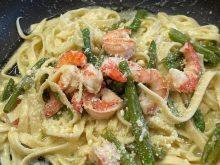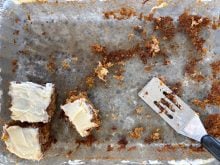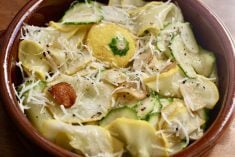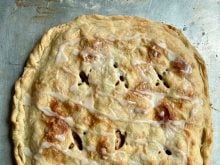Gifting is as much fun as receiving. I have brought together some ideas for the person who loves to be in the kitchen.
Gift cards are always welcomed. They are offered everywhere — wine stores, kitchen shops and grocery stores.
Clubs and subscriptions are also popular. Monthly or quarterly deliveries for cheese, coffee and baking, to name a few, may be purchased.
But if you are looking for something else, read on.
A cookbook is always a good choice. Eat Alberta First by Karen Anderson is a deep dive into all that is locally available, not only in Alberta, but across the Prairies.
Read Also

Know what costs are involved in keeping crops in the bin
When you’re looking at full bins and rising calf prices, the human reflex is to hold on and hope for more. That’s not a plan. It’s a bet. Storage has a price tag.
At 383 pages, it will take a while to cook your way through this book. The recipes are detailed and good for a novice in the kitchen, as well as the seasoned home cook. It is a good learning book and features tips and a few tutorials in addition to recipes.
Prairie by Dan Clapson and Twyla Campbell also features ingredients easily found on the Prairies. They take us through the seasons using what is available and combining new ideas with traditional garden and farm ingredients.
Okanagan Eats is a very approachable cookbook of chef recipes. They are fancy enough but not so fancy that you would spend hours in the kitchen and be searching for obscure ingredients.
Tawaw by Shane Chartrand and Jennifer Cockrall-King focuses on traditional ingredients of our Indigenous peoples with modern day interpretations. Chartrand is the head chef of Indigenous programs at the Banff Hospitality Collective.
Duchess Bake Shop by Giselle Courteau, who opened a bake shop in Edmonton by the same name, has become one of my favourite baking cookbooks. Recipes for croissants, pate a choux, pastries, cakes and others are detailed enough for a novice baker to follow and succeed.
Beet Cured Salmon with Chanterelles and Saskatoon Sauce
Other wild mushrooms may be substituted for the chantarelles in this recipe.
For the cured salmon:
- 1/2 c. sugar 125 mL
- 1/4 c. kosher salt 60 mL
- 1/2 c. fresh beet juice 125 mL
- 1 1/2 lb. sashimi grade King salmon fillet, skin on and pinbones removed 750 g
For the mushrooms:
- 2 tbsp. canola oil 30 mL
- 2 large shallots, finely diced
- 2 c. chanterelle mushrooms 500 mL
- salt, to taste
For the saskatoon berries:
- 1 c. saskatoon berries 250 mL
- 2 cinnamon sticks
- 2 bay leaves
- 2 tbsp. sugar 30 mL
Make the beet-cured salmon first. Combine sugar and salt. Place fillet on a rimmed baking sheet and cover both sides in the sugar mixture. Pour the beet juice evenly over the fillet. Cover loosely with plastic wrap and refrigerate for 24 hours.
Prepare the mushrooms by heating the oil in a pan over medium-high heat. Add shallots, mushrooms and salt. Cook until very soft, about eight minutes. Remove from heat.
Prepare saskatoon sauce by combining all ingredients in a small pan over medium-high heat until the berries burst. If the berries are very dry, add a splash of water. Remove bay leaves. Cool.
Prepare the salmon by removing it from the cure, lightly rinsing in cool water and patting dry. Cut the salmon into thin slices, against the grain.
For serving, smear a spoonful of saskatoon sauce on each serving plate. Arrange sauteed mushrooms on the plate and top with slices of cured salmon.
Adapted from Tawaw by Shane Chartrand and Jennifer Cockrall-King.
Sweets and Christmas go hand-in-hand but what about the friends who may not like sweets or are diabetic? This seedy topping for salads dresses up the simplest of salads to make it special. A gift from your kitchen to theirs.
Seedy Salad Topping
- 3/4 c. sunflower seeds 175 mL
- 3/4 c. dried cranberries 175 mL
- 1/2 c. pumpkin seeds 125 mL
- 1/2 c. almonds 125 mL
- 1/4 c. quinoa 60 mL
- 1/2 c. pecans 125 mL
- 1/2 c. Three Farmers chickpeas 125 mL
- 1/2 tsp. kosher salt 2 mL
Combine all ingredients and store in an airtight container.
Paella is a traditional Spanish meal originating in Valencia. A paella kit can be as economical or lavish as you choose. Paella pans run from $35 to $900 for a heavy stainless steel pan clad in copper. Add a bottle of good quality Spanish extra virgin olive oil, Spanish saffron, a bag of bomba rice and a good recipe.
Shellfish Paella
- 1/4 c. olive oil 60 mL
- 2 lb. chicken legs and thighs, skin on, cut into small serving pieces 1 kg
- 1 medium onion chopped
- 3 ripe tomatoes, peeled, seeded and chopped
- 4 c. hot chicken stock 1 L
- 1 c. cooked white kidney beans, rinsed and drained if canned 250 mL
- 1 c. cooked butter beans 250 mL
- 1 c. cooked green beans, preferably Italian style flat beans 250 mL
- 12 scrubbed mussels
- 12 scrubbed clams
- 8 oz. firm white fish, cut into small serving pieces 250 g
- 1 lb. peeled, deveined raw shrimp, preferably with tails on 500 g
- 8 oz. Spanish chorizo, diced 250 g
- 1 tbsp. sweet smoked paprika 15 mL
- 6 – 8 crumbled saffron threads
- salt to taste
- 1 lb. bomba rice 500 g
Heat olive oil in a large paella pan or shallow skillet. Add chicken pieces and brown them. Do this in batches, if necessary. As these are done, remove to drain on a cooling rack placed on a sheet pan.
Pour off all but one tablespoon (15 mL) of fat, add onion and tomatoes and cook stirring often, over very low heat, until softened.
Return the chicken to the pan and stir well.
Add chicken stock. Bring to a simmer and add the remaining ingredients.
Make sure ingredients are well distributed and gently pat down the top. Cook, uncovered and without stirring, over medium-high heat until the rice is done and the liquid is evaporated, 20 to 25 minutes.
If the liquid evaporates too quickly, add more hot stock as needed. Do not allow the rice to burn; however, a dark brown crust on the bottom of the pan is desirable.
When the paella is done, let stand for 10 to 15 minutes before serving. Garnish with large lemon wedges. Serves eight people.
Sarah Galvin is a home economist, teacher and avid supporter of local food producers. She has been a market vendor, grew up on a farm in southeastern Saskatchewan and is a member of TEAM Resources.
















